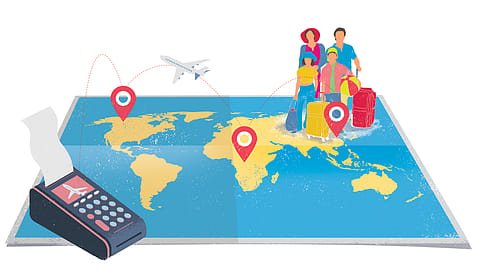India’s travel boom: 5.2 billion trips by 2030, but supply trails demand, says Booking.com
Average monthly searches for domestic travel jumped from 103 million in 2022 to 141 million in 2024, showing a consistent uptick in intent, according to the latest report by Booking.com.

India’s domestic travel story is only getting bigger. By 2030, Indians are expected to take nearly 5.2 billion trips, most of them within the country. The opportunity and the challenge lies in matching this surge with enough supply to keep pace.
“Demand continues to outpace supply,” says Santosh Kumar, Regional Manager, South Asia at Booking.com. “Supply is growing at about 8%, but demand is growing faster. That’s the opportunity - to bridge that gap through investment, infrastructure, and policy support.”
India’s hospitality sector is clearly in a high-growth phase. Average monthly searches for domestic travel jumped from 103 million in 2022 to 141 million in 2024, showing a consistent uptick in intent, according to the latest report by Booking.com. Hotel demand is projected to rise 10.5% annually till 2027, outpacing the 8% growth in supply, while the branded hotel supply still sits modestly at 138 rooms per million people compared to over 1,500 per million in more developed markets.
Kumar points out that infrastructure and last-mile connectivity have improved significantly over the last decade, but the sector still needs to scale faster. “It’s not that supply isn’t growing. It is. But the pace at which Indians are travelling has far exceeded what’s available,” he says, adding that easing regulatory clearances and promoting skilling and sustainability will be critical to close the gap.
At present, India’s total room supply stands at around 2.48 million and is projected to reach 3.1 million by 2029, reflecting the scale of opportunity for hotel operators and investors. Nearly 70% of India’s lodging market still consists of unbranded and alternative accommodations, which Kumar sees as a key lever to plug the gap faster. “Short-term rentals can be added much quicker than traditional hotels,” he says.
What’s also changing is how Indians think about travel itself. The accommodation has become the destination, driven by travellers who are spending more time on-site, according to the report. “Indians are willing to spend on experiences such as food, spas, and other fun activities,” Kumar notes. Around 80% of Indian travellers plan to spend most of their time at the property, compared with a global average of 51%, which has boosted non-room revenues to nearly 50% in the premium segment.
Occupancy levels in India are currently around 68%, and this demand is becoming more consistent across the year. In 2024, off-season volumes held at 63% of peak levels, up from 57% in 2023, signalling that travel is now less seasonal. Tier-II and Tier-III cities are driving this change, with occupancy now sustained across the year.
Kumar says Booking.com’s research also shows evolving travel personas - from young “next-gen co-pilots” influencing family trips, to women travellers playing a stronger role in planning, to older “timeless travellers” seeking culture and connection.
As India moves toward becoming one of the world’s largest travel markets, Kumar sees an ecosystem ready for rapid evolution. “Ninety to ninety-five percent of our demand is domestic today,” he says. “That’s a massive base. The opportunity is to ensure that infrastructure, supply, and experiences keep up with how Indians are redefining what travel means.”